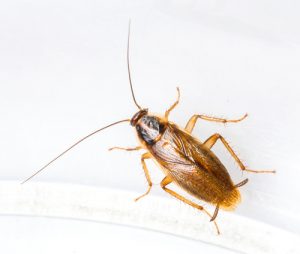German Roach: Restaurateur and Urban Traveler
By Chris Williams on January 30, 2012.
The German cockroach has been around for a long time. Originally from East Africa, these hardy hitchhikers have spread around the globe. Warm jungle conditions with abundant food sources and lots of leaf litter gave German cockroaches perfect habitat. In nature, pressure from predators forced cock roaches into hiding in close dark spaces, and feeding primarily at night. With tremendous reproductive capacity, German cockroaches were able to find their way into and among human habitations and food stores. Transported through trade and travel on ships German cockroaches followed civilization. As cities developed so did the demand for goods and food, and the spread of the German cockroach. In modern times German cockroaches continues to thrive.
 Due to their evolutionary path, German cockroaches prefer warm, damp locations with plentiful food resources nearby. Kitchens provide this and more! Combine the perfect habitat with constant incoming produce and boxed goods and it is easy to see the potential. Once German cockroaches arrive at a new location, they settle in quickly and begin to reproduce. It’s not long before the first generation emerges and begins to explore and expand into new territory. Next thing you know, the kitchen is infested! As the infestation grows, German cockroaches may travel to adjacent rooms, other units, and even travel through sewers to neighboring buildings in search of new living spaces. Roaches may also get into clothing, backpacks, handbags, or take out containers and bags and arrive at your house.
Due to their evolutionary path, German cockroaches prefer warm, damp locations with plentiful food resources nearby. Kitchens provide this and more! Combine the perfect habitat with constant incoming produce and boxed goods and it is easy to see the potential. Once German cockroaches arrive at a new location, they settle in quickly and begin to reproduce. It’s not long before the first generation emerges and begins to explore and expand into new territory. Next thing you know, the kitchen is infested! As the infestation grows, German cockroaches may travel to adjacent rooms, other units, and even travel through sewers to neighboring buildings in search of new living spaces. Roaches may also get into clothing, backpacks, handbags, or take out containers and bags and arrive at your house.
German cockroaches have the highest reproductive capacity of all the domestic cockroach species. Females, who can live as long as 200 days, mate and lay egg cases. Each egg case may produce around 40 tiny nymphs who undergo six growth stages, called instars, before becoming viable adults. It take roughly 90 days, depending on the temperature, for complete development. A female may lay as many as four egg cases in her lifetime. Egg cases are carried by the female until just before hatching, at which time it dropped off. Because the egg carrying females remain in their harborage for most of the time, eggs may be hidden in these same places. In large infestations females may be forced out of hiding and egg cases may be found on counters or floors, having dropped in the night.
Because German cockroaches prefer the hidden, often less than clean locations, their hairy legs and flattened bodies are ideal for picking up disease causing organisms. Travel in search of food leads to contact with utensils, plates, glasses, surfaces, pots, and pans. Salmonella, E-coli, viruses, bacterial agents of cholera, pneumonia, diphtheria, tetanus, undulant fever, cerebrospinal fever, anthrax, tuberculosis, and other protozoans known to cause diarrhea. Toxoplasmosis has also been shown to be acquired by German cockroaches through the ingestion of infected cat feces and then transmitted to man through contact with contaminated cockroach feces. Documented cases of allergic reactions leading to asthma due to contact with dried German cockroach feces and tiny particles of dead roaches that become air born. In heavy infestations this material can build up over time.
Control of German cockroaches requires an integrated approach. The use of Integrated Pest Management techniques is essential in dealing with this highly successful evolutionary wonder bug. Any management plan begins with a Pest Control Professional doing a thorough inspection to determine the scope of the infestation. Conditions that allow roaches to thrive will be noted.
Construction issues such cracks and holes, wall void openings, broken pipes, water leaks, and clogged drains need to be addressed first. Sanitation practices and procedures need to be considered as well. Roaches will eat a wide variety of foods including their own dead bodies, hair/pet fur, grease, all manner of vegetables and meat, the more spoiled the better. Pet feces, especially that of older pets with poor digestion is also a suitable food source.
By removing or limiting access to harborage sites and reducing moisture as much as possible, conditions become less favorable. Good sanitation practices and techniques must be utilized to remove any available food sources on a continuous basis. Pest Control Professionals may also utilize certain materials to knock down the population. Flushing agents combined with Insect Growth Regulators(IGRs), and or residual formulation can be used to get quick results in heavy infestations. Baits place in cracks and crevices, wall voids, and other harborage sites, combined with IGRs act as effective long term control agents. The use of monitors that capture German cockroaches is also an effective way to determine if control measures are working and look for new activity. Long term management of German cockroaches is best accomplished through a program involving monthly inspections by a Pest Control Professional.